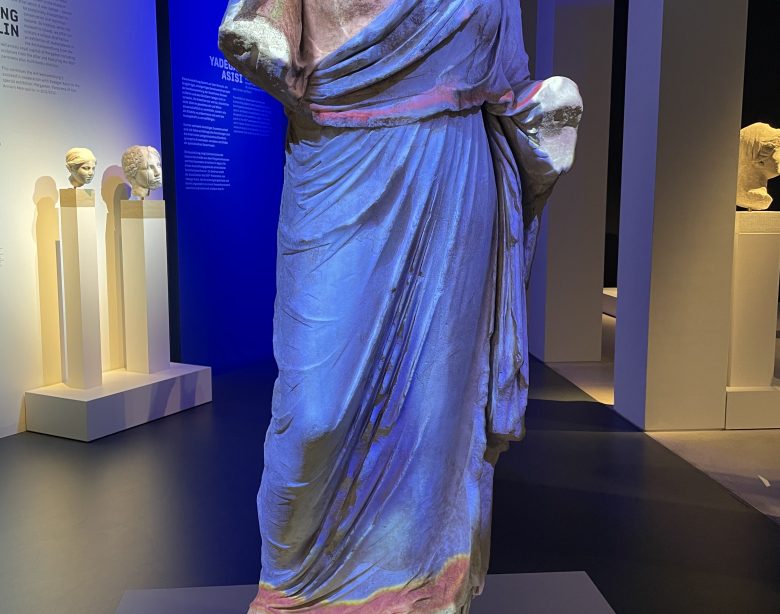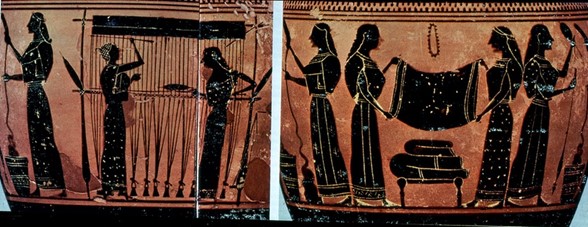This week it is time for something different! What did the Greeks wear? How did they make their clothes? What were the different styles that were popular among the Greeks? Guest Author Michelle Stamov takes us on a journey into the world of Greek Clothing and tries to answer these questions and more.

Clothing is an often-overlooked element in the lives of the ancient Greeks but is essential in understanding not only their everyday lives but their technology and society. Textile production requires equipment and skills- so the process would take up a lot of time. Generally, these sorts of skills were associated with women and were not thought of as a ‘high art’, so they are swept to the side. I would argue that how we think of clothing and its production plays a huge part in the way interpret and picture a culture, thus gaining a better grasp helps one understand certain nuances. This can often be helpful in the observance of ancient art, as a lot of can be told about a figure by what clothing they are depicted in. The idea of the ancient Greek in a white toga is a huge staple in the public’s imagination of the period, but how accurate is it?
Many issues come about with the study of textiles in the past; primarily that, they are made of organic matter and we do not have actual garments to reference. We are left then with literary accounts and artistic depictions. There is some archeological evidence that helps us gain an insight as well, such as loom weights, clasps, and pins. It should also be noted that details changed temporally and geographically, and this blog post intends to give an overview.
Styles

On the surface, Greek clothing appears quite simple in construction. While elements would change according to different genders, jobs, and economic statuses; the concept behind clothing was essentially a long, woven fabric (wool or linen, or sometimes cotton was imported) which would be draped around the body in a seemingly endless variety, fastened together by clasps and pins, and sometimes belts or sashes were added (peplos and chiton). Little to no sewing was involved. Another piece of fabric was generally worn overtop as a type of cloak (himation). People would often go barefoot, but leather sandals were also worn. There are a few distinct styles we can observe, each with its own set of variations. Here we will briefly discuss three of the most prominent in women’s clothing.
The Chiton (often classified into Doric or Ionic) was made of a long rectangular piece of fabric, which was fastened together at the shoulders. It was sometimes paired with a girdle at the ribs, and a himation overtop. The himation was yet another cloth rectangle, which was draped over the body in various ways, often like a cloak or sometimes even a veil.

Similarly, the Peplos also constituted of a long rectangular material but was then folded and hung at the shoulders, creating the appearance of multiple pieces being draped. A girdle or belt was often worn at the waist. This style of women’s garnet is depicted in famous statues such as the Peplos Kore and is often depicted as being worn by Athena. c.530B.C. Peplos Kore.
Production:
So, we have a better picture of the way Greek clothing was worn, but how was it produced? We can observe the use of the warp-weighted loom from Bronze Age Greece, and the procedure stayed the same up through the Hellenistic period. Fabrics were often woven either at home or in a workshop by groups of women. It would begin by processing various fibres through a means of retting, washing, and combing. The fibres were then spun by a weighted spindle and woven from top to bottom on the loom. Here we can see the 2ndcentury rhetorician Pollux describing the equipment used for Spinning and Weaving:
“In a few words one can pull together the rest of those items that pertain to the women’s quarters: woven baskets and baskets with narrow bottoms and the smaller types of both.. and the spindle and the circular whorls, the skeins of yarn, the weaver’s shuttle, and the comb of the loom; and the weaver’s rod [to attach the alternate threads of the warp] and the beam along with the vertical beams of the loom [between which the web is stretched]; and the stone weights [for the warp threads] and the loom weights, and the flat blade [to strike the weft threads home].” (Pollux, Lexicon 10.124-125)
Amasis, 6th cent. B.C. c.560 B.C. Lekythos: Reverse: Women Working Wool: Two views. Place: Metropolitan Museum of Art (New York, N.Y.)
While Greece is often depicted as a land dotted with stark white marble architecture, and people wandering about in simple white togas, it was far more colorful than that. Temples and statues were brightly painted, and clothing was also treated in similar regard. Dyed fabrics, of course, were more expensive, so bright colors were often associated with wealth. The disadvantaged Greeks would make do with whatever undyed fabrics they could afford, and many of them worked in facilities that produced these colorful dyes. One of the most expensive and sought-after colors was Tyrian purple. This dye was made from the secretion of various snail species often referred to as ‘murex’ snails. It was labour intensive and required many snails to produce a dye, therefore required murex production facilities. These places were often quoted as being notoriously smelly.
 Would you ever try recreating an ancient Grecian outfit? How would you feel if you found out a smelly murex facility was being built in your neighborhood? Let us know in the comments! This guest post was written by Michelle Stamov, an undergraduate student at the University of Calgary. I am working towards my BA in Ancient and Medieval history and will be graduating in the spring. I am currently researching funerary practices in the Ancient Greek world.
Would you ever try recreating an ancient Grecian outfit? How would you feel if you found out a smelly murex facility was being built in your neighborhood? Let us know in the comments! This guest post was written by Michelle Stamov, an undergraduate student at the University of Calgary. I am working towards my BA in Ancient and Medieval history and will be graduating in the spring. I am currently researching funerary practices in the Ancient Greek world.
Further reading:
Abrahams, Ethel Beatrice. Greek Dress A Study of the Costumes Worn in Ancient Greece, from Pre-Hellenic Times to the Hellenistic Age. Project Gutenberg.
Humphrey, John William. Ancient Technology. Greenwood Guides to Historic Events of the Ancient World. Westport, Conn.: Greenwood Press, 2006.
Johnson, Abrahams, Evans, Johnson, Dorothy M, Abrahams, Ethel Beatrice, and Evans, Maria, Lady. Ancient Greek Dress. Argonaut Library of Antiquities. Chicago: Argonaut, 1964.
Lee, Mireille M. Bodies, Dress, and Identity in Ancient Greece. New York: Cambridge University Press,2015.
Llewellyn-Jones, Blundell, Llewellyn-Jones, Lloyd, and Blundell, Sue. Women’s Dress in the Ancient Greek World. London : Swansea, Wales : Oakville, Conn.: Duckworth ; Classical Press of Wales ; Distributor in the United States of America, David Brown Book, 2002.
Pollux, Lexicon 10.124-125.





